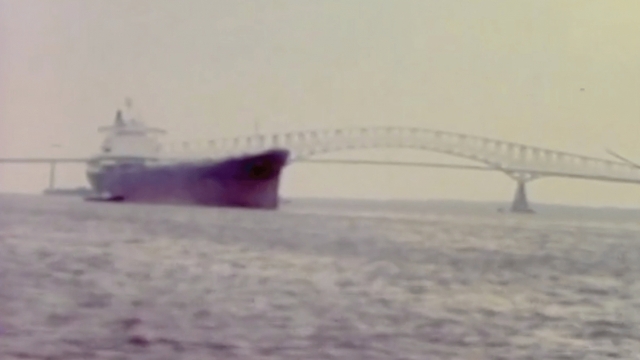The Scripps News investigative team has unearthed decades-old videos that help explain why the fallen Francis Scott Key Bridge in Baltimore was not equipped with stronger protection around its supports to guard against getting hit by a ship.
The first video is a story that aired in 1977 on WMAR-TV, Scripps News Baltimore, days before the bridge opened.
As a reporter drives across the gleaming new span over the Patapsco River, construction crews are seen finishing up last-minute work.
The report focuses on the traffic the bridge would alleviate from a busy nearby tunnel.
But just three years later, in 1980, a catastrophic event in Florida would suddenly shift attention to the support structure beneath the Key Bridge, and others like it around the U.S.
A cargo ship smashed into a piling on the towering Sunshine Skyway Bridge in Tampa, bringing down part of the bridge and spilling cars into the bay below, killing 35 people.
Another report from WMAR-TV shows how the disaster opened eyes in Maryland to the threat of a ship striking the Francis Scott Key Bridge, just 3 years old at the time.
“Some 4,000 ships travel in and out of the bay every year,” the reporter says in the story that aired in May 1980. “The question is: Could what happened in Florida happen here?”
SEE MORE: Workers apparently had little warning as Maryland bridge collapsed
A senior pilot who helps guide ships in and out of the port then explains why he thinks a vessel striking a pier on the Key Bridge would be so unlikely.
He notes the straight direction of the channel, as well as its width and depth, and says the design gives ships plenty of room to maneuver around the bridge.
“In this channel, it’s a good 800 feet wide or better,” the pilot says. “We're lined up well for the bridge. There's a wide channel. It’s fairly deep.”
Just three months after that interview, two incidents would boost confidence that the Key Bridge could indeed survive a ship colliding with it.
U.S. Coast Guard records that Scripps News obtained from the National Archives detail an accident remarkably similar to what occurred 44 years later.
In August 1980, a Japanese container ship named Blue Nagoya lost electricity and was “dead in the water,” according to the Coast Guard documents.
The barge drifted into a "concrete shield around a support piling of the Key Bridge.” A 1983 report by the National Research Council described the barrier as a "crushable protective structure surrounding the pier” that “proved effective in absorbing a direct collision.”
SEE MORE: Could tugboats have helped avert the bridge collapse in Baltimore?
That was not the only mishap that evening involving a ship and a bridge in Maryland.
Hours earlier, another ship hit a pier on the nearby Chesapeake Bay Bridge.
Once again, WMAR-TV was on the scene.
“We’re going to go down now and get on a boat and see exactly how much damage was done,” a reporter says, who then adds that a tugboat pulling a barge had run into a concrete barrier protecting one of the pilings on the bay bridge.
“A look at the barge showed a very large dent,” the reporter says. “Some of the crumpled concrete was still on the deck. No one was hurt.”
The vessels in both incidents were nowhere near as large as the mammoth cargo ships of today.
Footage from the early days of the Francis Scott Key Bridge shows much smaller, lighter ships going in and out of the port.
The Dali barge, by contrast, was about as long as the Eiffel Tower is tall.
“It's difficult to overstate the impact of this collision we're talking about,” said Transportation Secretary Pete Buttigieg during a White House news conference March 27. “It’s not just as big as a building. It's really as big as a block — 100,000 tons all going into this pier all at once.”
The Maryland Transportation Authority has not yet responded to questions from Scripps News about what protective structures were in place around the pilings before the Dali took down the bridge or why, as ships got bigger, the anti-collision systems around the bridge didn’t grow with them.
Trending stories at Scrippsnews.com



